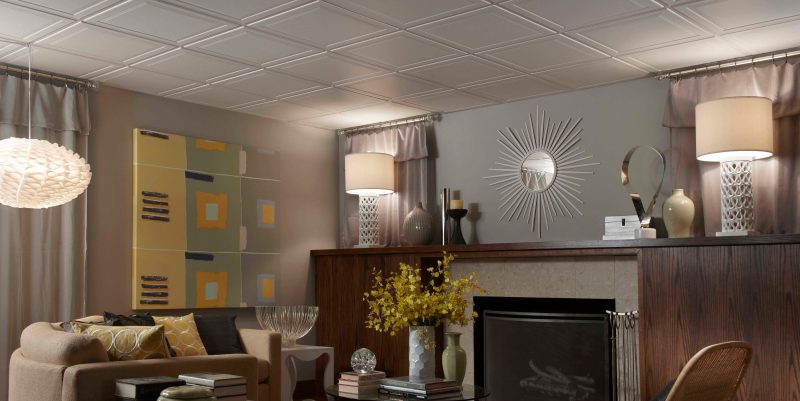Acoustic panels for ceilings enhance sound quality by reducing noise and echoes. They are essential for optimizing acoustics in various spaces, from home theaters to conference rooms.
Investing in acoustic panels for your ceiling can transform a noisy, reverberant area into a clear-sounding space. Ideal for both commercial and residential settings, these panels work by absorbing sound waves, thereby diminishing sound reflections that can muddle audio clarity.
Their practicality extends to recording studios, offices, and educational institutions, where clear sound is imperative. Available in several materials, sizes, and designs, ceiling acoustic panels not only improve auditory experiences but can also add an aesthetic touch to your interiors. Their installation is considered a smart move for anyone looking to create an acoustically pleasant environment without compromising on style.
Why Invest In Ceiling Acoustic Panels
Good acoustics improve our daily lives. Spaces with great sound make us feel better. Ceiling acoustic panels are key for this. These panels cut noise and echo. They let us hear clearly.
Balancing Sound In The Room
Looking for clear sound? Ceiling acoustic panels are a must. They manage echo in rooms. Sound gets soft and balanced.
- Reduce harsh echoes
- Keep conversations easy to understand
- Help in controlling sound levels
Aesthetics Meets Functionality
Beautiful designs meet sound control. Ceiling panels come in many styles. They enhance room look and feel.
| Design | Function |
|---|---|
| Colors and Textures | Sound Absorption |
| Shapes and Sizes | Noise Reduction |
Types Of Acoustic Panels For Ceilings
Revamping your space with acoustic panels for ceilings can lead to improved sound quality and aesthetic appeal. With various types to choose from, the perfect fit for your area is within reach. Let’s explore the types of acoustic panels for ceilings to help you make an informed decision about your acoustic treatment options.
Fabric Wrapped Panels
Fabric wrapped panels offer aesthetic flexibility and sound absorption. These are available in different colors and sizes to match your decor. They consist of a sound-absorbing core material, like fiberglass, covered with fabric. These panels can reduce echo and improve speech clarity.
Perforated Acoustic Wood Panels
Perforated acoustic wood panels bring a natural touch to sound control. They have holes or slits that allow sound to pass through and get absorbed by backing materials. These panels blend seamlessly with wooden aesthetics and are often used in auditoriums and conference rooms for their effective sound dampening qualities.
Foam Acoustic Panels
Foam acoustic panels are popular for their efficiency and ease of installation. Made of polyurethane or melamine foam, they can alter sound energy into heat. These panels are cost-effective solutions for studios and home theaters, cutting down on excess reverberation.
Customizable Acoustic Panel Options
For those who require unique solutions, customizable acoustic panel options are the answer. Custom panels can be cut into various shapes and printed with personalized designs. They address specific soundproofing needs and allow for creativity, making them a perfect choice for unique spaces.
Deciding On The Right Panels For Your Ceiling
Deciding on the right acoustic panels for your ceiling is a key step in improving the sound quality of a room. It helps in reducing noise, controlling echo, and enhancing the clarity of speech and music. Let’s explore the factors to consider to ensure the best choice for your space.
Considering Room Size And Ceiling Height
The dimensions of the room significantly affect acoustic panel selection. Large rooms or those with high ceilings often require more coverage or specialized panels to effectively absorb sound. Let’s look at the details:
- Volume and surface area: Calculate the room’s volume to estimate the necessary amount of acoustic treatment.
- Reflection points: Identify walls and surfaces where sound bounces back to prioritize panel placement.
Material And Design Considerations
Acoustic panels come in a variety of materials and designs, each with its unique sound-absorbing properties.
- Fiber Materials: Panels made of fibers like cotton or wool are great for high-frequency absorption.
- Foam Panels: These are lightweight and can absorb mid to high frequencies effectively.
- Wooden Panels: Add elegance while buttering low-frequency sounds.
Choose a design that complements your interior and meets your acoustic needs.
Installation And Mounting Systems
Selecting the proper installation method is crucial for both safety and effectiveness. Here’s what to consider:
- Direct Mount: Ideal for smaller panels, perfect for pinpointed sound control.
- Cloud Mounting: Suspend panels from the ceiling for enhanced sound absorption and aesthetic appeal.
- Track Systems: Allows for easy panel adjustment and is suitable for larger installations.

Credit: sound-zero.com
Installation Tips For Optimal Acoustics
Installing acoustic panels on the ceiling can transform a noisy room into a peaceful space. Proper installation is key to achieving the best sound control. Follow these tips to ensure your acoustic panels work effectively.
Tools And Prep Work
Before starting, gather the right tools. Here’s what you need:
- Measuring tape
- Stud finder
- Drill with bits
- Screws and anchors
- Level
- Chalk line or laser level
Preparing the ceiling is next:
- Determine panel layout for even coverage.
- Find and mark stud locations.
- Use chalk line to mark guide lines.
Step-by-step Installation Process
Installation is straightforward if you follow these steps:
- Hold the first panel against the ceiling.
- Mark drill holes using the panel’s mounting points.
- Drill holes and insert anchors if needed.
- Secure the panel with screws. Use a level to ensure it’s flat.
- Repeat for remaining panels, checking alignment.
Troubleshooting Common Issues
Sometimes problems arise. Here’s how to fix them:
| Issue | Solution |
|---|---|
| Panels not level | Adjust screws and use a level to align. |
| Uneven spacing | Measure and adjust according to layout. |
| Poor sound improvement | Check for gaps and seal them properly. |
Beyond The Ceiling: A Holistic Approach To Acoustics
Imagine a space where every sound is crystal clear. This is the power of a holistic acoustic approach. It’s not just about acoustic panels for the ceiling. It’s about treating every surface in a room to create the perfect sound environment. This blog section digs deep into how integrating different elements can enhance overall acoustics. From walls and floors to furnishing and upkeep, discover the full spectrum of soundproofing.
Integrating Wall And Floor Treatments
Walls and floors play a huge role in acoustics. Sound bounces, and these surfaces can either amplify noise or dampen it. Use the right materials, and the space will sound better.
- Choose absorbent wall panels that complement those on the ceiling.
- Install thick carpets or specialized acoustic flooring to reduce echo.
Furnishing For Better Sound
Select furniture that not only looks good but also improves sound quality. Soft, plush items can absorb noise, leading to clearer acoustics.
| Furniture Type | Acoustic Benefit |
|---|---|
| Soft sofas and chairs | Sound absorption |
| Bookshelves | Diffuse sound waves |
Regular Maintenance For Acoustic Panels
Keep panels performing at their best with regular cleaning and checks. Dust and dirt can affect how sound is absorbed.
- Vacuum panels gently to remove surface dust.
- Check for any signs of damage that might need repair.
- Ensure panels are firmly attached and haven’t come loose over time.

Credit: arktura.com
Case Studies: Transformations With Ceiling Acoustic Panels
Ceiling acoustic panels are revolutionizing interior spaces. They enhance sound quality and offer aesthetic appeal. This section dives into real-life transformations. We’ll explore how varied sectors benefit from ceiling acoustic panels.
Home Theaters And Listening Rooms
Private residences have seen dramatic improvements. Familiar complaints of echoes and noise pollution resolved with ease.
- Clarity of sound achieved for immersive experiences.
- Design flexibility helps blend with room aesthetics.
- Material variety matches unique needs.
One case study showcases a suburban home theater. Family movie nights transformed with crisp, clear audio. Distractions from other rooms now a thing of the past.
Restaurants And Acoustic Challenges
Eateries confront sound issues. Managing diners’ buzz while maintaining ambiance is key.
| Before Installation | After Installation |
|---|---|
| Noise levels high | Conversations clear |
| Ambiance disrupted | Atmosphere perfected |
A bistro in the city center exemplifies success. The installation of ceiling acoustic panels has seen diners stay longer and return often.
Commercial Spaces And Privacy Concerns
Office spaces are embracing acoustic ceiling solutions. Confidential discussions need privacy. Ambient noise distractions reduced.
- Productivity rises as noise pollution drops.
- Private meetings remain discreet.
- Work environment aesthetics improved.
A high-profile law firm now boasts an environment conducive to concentration. Client comfort and trust levels at all-time highs.

Credit: www.armstrongceilings.com
Frequently Asked Questions On Acoustic Panels For Ceiling
Do Acoustic Panels Work On Ceiling?
Yes, acoustic panels effectively reduce noise when installed on ceilings. They absorb sound waves and prevent echo, enhancing room acoustics.
How Do You Attach Acoustic Panels To The Ceiling?
To attach acoustic panels to the ceiling, use adhesive to secure directly or install mounting brackets to hold the panels in place. Ensure the surface is clean and measure accurately for even placement. Safety should be your top priority during installation.
What Is The Best Soundproofing For Ceilings?
The best soundproofing for ceilings typically involves using mass-loaded vinyl (MLV), acoustic panels, or soundproofing drywall to dampen noise. Installing resilient channels can further isolate ceiling drywall from noise transmission.
Are Acoustic Ceiling Tiles Worth It?
Acoustic ceiling tiles effectively reduce noise, making them a valuable investment for enhancing sound quality and comfort in interior spaces. They are also aesthetically versatile and can improve insulation.
Conclusion
Summing up, ceiling acoustic panels are essential for optimal sound quality. They reduce noise, enhance clarity, and can add a touch of style. Whether it’s for a home theater, studio, or office, these versatile panels promise an improved auditory experience.
Consider upgrading your ceiling with acoustic panels and enjoy the difference they make.